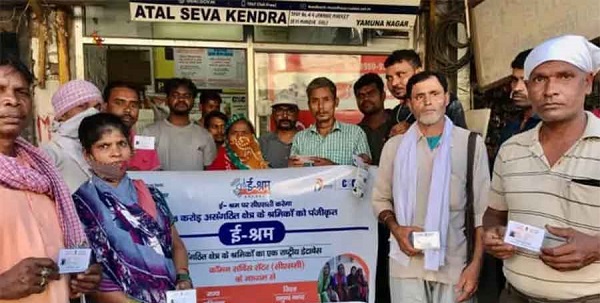e-Shram: Database of Unorganized Sector Workers

This topic of “e-Shram: Database of Unorganized Sector Workers” is important from the perspective of the UPSC IAS Examination, which falls under General Studies Portion.
What is e-Shram?
- E-Shram is a portal that is to serve as a database of unorganized sector workers in India.
- It was launched by the Ministry of Labour and Employment.
- The government seeks to register some 38 crore workers from the sector- including construction workers, migrant workforce, domestic workers and street vendors.
- Under this initiative, the workers are issued an e-Shram card bearing a 12 digit unique number. This is to help their inclusion in social security schemes.
- The registration work is coordinated among the Labour Ministry, state government, trade unions and common service centres.
- Registration on the portal can be done using Aadhaar number and bank account details. The process also collects information like date of birth, mobile umber, social category and home town.
- It also collects information about the occupations in which the workers are engaged.
- A national toll free number was launched to address the workers’ queries.
- Awareness campaigns are also included in the plans.
What is the current state of the project?
- About 1/5th of the estimated number of unorganized sector workers are now registered in the database.
- In terms of coverage, Odisha leads with 87% of its unorganized workers already registered in the database. Other top states are West Bengal, Chhattisgarh, Jharkhand and Bihar.
- According to preliminary snapshot of the database:
- Category-wise breakup:
- 40.5% of the workers are from the OBC category
- 27.4% are from the general category
- 23.7% of the workers are from the Schedule Caste category
- 8.3% of the workers are from the Scheduled Tribe category
- Occupation-wise breakup:
- Agriculture sector with 53.6%– the maximum registration
- Construction sector with 12.2%
- Domestic and household workers with 8.71%
- Category-wise breakup:
Why is it significant?
- During the pandemic-driven lockdown in 2020, the migrant labour crisis exposed the shortcomings of India’s social security architecture.
- The key reasons for the limited policy support for this vulnerable section- especially during a period of acute economic stress are:
- Lack of credible data on the migrant workforce
- Inability to quickly identify the migrant workforce
- The crisis showed that this dearth of data extended beyond the migrant workforce and encompassed the entire unorganized sector workforce.
- This unorganized sector labour-force accounts for some 90% of the country’s entire labour force.
- The type of information revealed even by the preliminary data is vital given that some sectors have been hit worse than others by the pandemic’s fallout.
- This information could help the government tailor schemes to cater to those sectors that have borne the brunt of economic dislocation.
What is the way ahead?
- The information, gathered on the workers need to be regularly updated. This is especially needed in case of migrant workers.
- This needs to be done by the states of origin and the states of destination. This will help keep track of the migration pattern.
- There is a need to incentivize registration to cover those who are reluctant to register themselves.
- Several schemes have eligibility criteria that depend on data that isn’t collected by the portal. These too must be integrated.
- Need to examine the issue of portability of benefits, extended at both levels- central and states.
- The e-Shram initiative is a welcome move and is a long overdue step in the right direction.
- This is a necessary step to put a social security structure in place for a large section of India’s workforce.
- The database is set to be linked to Unnati– a proposed platform for matching labour with employment demand. This will further address the difficulties faced by the unorganized sector workers.
Conclusion:
The e-Shram initiative is a much needed step. However, the mere creation of a database isn’t sufficient. The government needs to identify and register the workers. This is necessary for their inclusion in social security schemes and for making India’s social security architecture robust.

